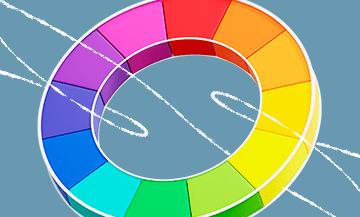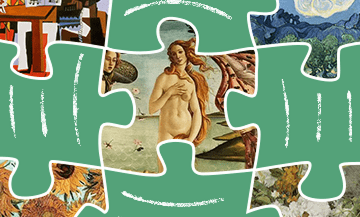If you want to learn oil painting on your own, you need to gather the necessary tools — let’s call it the creative kit. This process doesn’t require significant financial investment, but it will definitely bring you joy and pleasure.
In this article, I will discuss the essential supplies that no painter can do without.
Oil painting tools
To dive into the magical world of painting, you need to know not only the technique but also choose the right tools. Let’s talk about which tools will become your faithful companions on this exciting journey.
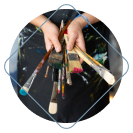 Brushes
Brushes
Brushes are the main tools for any artist, and for oil painting, they play a particularly important role. The main types of brushes are: flat, round, filberts, and medium-length brushes. Each brush has its own purpose, creating unique textures and lines on the canvas. Choosing brushes is your personal view of creativity, your chance to bring your imagination to life.
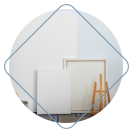 Canvas
Canvas
How can you start without a canvas — the framework for your fantasies? Canvases come in various textures, densities, and sizes. Priming the canvas before working gives additional opportunities for interaction with oil. Experiment with different types of canvases, and you’ll soon notice that each can add a special touch to your creation.
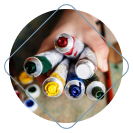 Oil Paints
Oil Paints
The palette of oil paints is vast, and every artist chooses their favorite shades. But the primary colors: red, blue, and yellow — they are the starting point for mixing and creating any other color you can imagine.
 Wooden Palette
Wooden Palette
You definitely need a wooden palette. An artist constantly mixes paints — it’s essential.
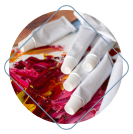 Paint Tubes
Paint Tubes
Tubes are convenient to use and allow for paint dosing. They also prevent the paints from drying out, keeping them fresh for future works.
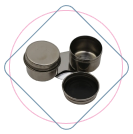 Palette Cup
Palette Cup
A palette cup is an indispensable accessory in the world of painting. It is a container designed for solvent. Opt for a special one with a lid and a way to attach it to the palette, or use a compact miniature cup.
To effectively clean your brushes, it is not recommended to rinse them under running water. Instead, gently dip the brush into the palette cup and carefully wipe it with a cloth. This simple yet important process will help keep your brushes clean.
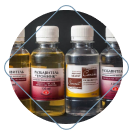 Paint Thinners
Paint Thinners
Solvent. For cleaning brushes and thinning paints, turpentine or mineral spirits are suitable.
Vegetable oils are also needed: linseed, poppy, safflower, and walnut, cold-pressed. They will give your works a special shade and texture.
A medium is a mixture of solvent and oil, ideal for reducing dry spots and opaque areas after the paint layer has dried.
Mediums are the artist’s secret weapon. Liquid mediums, consisting of acrylic resin and poppy oil, allow you to dilute paints without compromising their quality. Paste-like mediums, on the other hand, add volume to brushstrokes, creating unique textural effects.
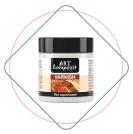 Varnishes
Varnishes
Varnishes can be classified into binders, cover, and retouching types. These compositions include various resins and solvents. Binder varnishes, such as pine, cedar, damar, and mastic, are used either in their pure form or as part of a mixture to dilute paint during the creative process.
Cover varnish (acrylic-peat or acrylic-styrene) is used for a complete coating of an already dried painting. Imported varnishes come as sprays, offering glossy and matte options.
Retouching (interlayer) varnish is used for smoothing out areas of an unfinished but already dried canvas if additional finishing is required. This type of varnish dissolves the top layer of paint, improving adhesion and preventing yellowing in multilayered works.

Painting Surface
Art supply stores offer ready-made surfaces, but if you want to start experimenting, there is no need to immediately buy a pre-primed canvas or cardboard. Alternatively, you can use hardboard painted twice with water-based paint.
Ready-made primer for oil painting is also available. It can be used to cover various surfaces — concrete walls, metal sheets, stones, to prepare them for the creative process. As for using canvas, it is first stretched onto a frame and covered with a special composition known as sizing.
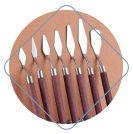
Palette Knife
A palette knife is a magical spatula that helps in spreading paints and creating three-dimensional forms.
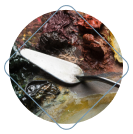
Scrapers and Palette Knives
Scraper-like tools and palette knives are used for mixing paints on the palette and applying them to the canvas.
Oil painting materials
What materials will make your painting truly inspiring and expressive when using oil paints? The right choice of materials is the first step towards creating a work of art that leaves an incredible impression.
![]() Oil Paint Set
Oil Paint Set
Choose oil paints that will become your color palette. You can start with a basic set of six colors. However, the more diverse the colors on your palette knife, the richer and more vibrant the shades on your canvas will be.
- Consider your needs: first, determine what you want to depict. If your creativity requires rich and vibrant colors, choose paints with a broad palette. If you are drawn to a subtle range or monochrome, opt for a more limited selection.
- Experiment with brands: oil paints are offered by various manufacturers, each with its own characteristics. Try different brands to find those that match your style and color perception.
- Quality above all: high-quality paints will provide more durable, rich, and deep shades. Although you may be tempted to save, invest in quality—it will enhance the beauty of your creation.
- Texture variety: vary the textures of the paints. Some brands offer thick, oily paints, while others are lighter and more transparent. Play with different textures.
- Consider your style:your painting style is your artistic signature. For example, if you prefer Impressionism, bright and rich colors will be your best friends.
- Complex shades and mixing:choose paints that mix easily.
![]() Mastering Knife
Mastering Knife
A mastering knife, a blending tool, will add softness to your color transitions and create an atmosphere of unique harmony in your painting.![]() Linseed Oil
Linseed Oil
Linseed oil adds flexibility to paints, improves their flow, and makes the colors more vibrant and deep. It’s an invisible artistic touch that makes your painting more picturesque.
Choosing quality materials is not only an investment in your creativity but also a way to give your ideas the utmost expression and beauty.


Creative atmosphere for oil painting
Inspiration is born from the tiniest details of the surrounding world, and to make your brushes magical wands, you just need to add a bit of magic to your creative space.
How to set up your workspace to make it a place where you want to create?
- Place of Inspiration: find your place of inspiration where you feel comfortable. It could be a corner in your studio or even a cozy window with a view of nature.
- Lighting: use natural lighting if possible. It will create more natural colors and promote productive work.
- Sound Atmosphere: add music or sounds that resonate with your emotions. It could be the sound of rain, a gentle melodic background, or even the quiet voice of nature. Sound is an additional layer of your creativity.
- Inspiration Scents: don’t forget about scents. The aroma of fresh paints, oils, or even candles can awaken additional senses, immersing you in a world of inspiration.
- Creative Rituals: develop your own creative rituals, whether it’s a cup of aromatic tea before starting work or a short meditation to set a positive mood.
- Materials and Tools: try to keep all necessary materials within reach to avoid breaking the flow of creativity.
- Continuous Learning: keep learning and delve into various styles and techniques of painting. Don’t be afraid to experiment with new ideas and approaches to art.
Find what inspires you specifically. Remember, the magic of creativity is a process, not a result.
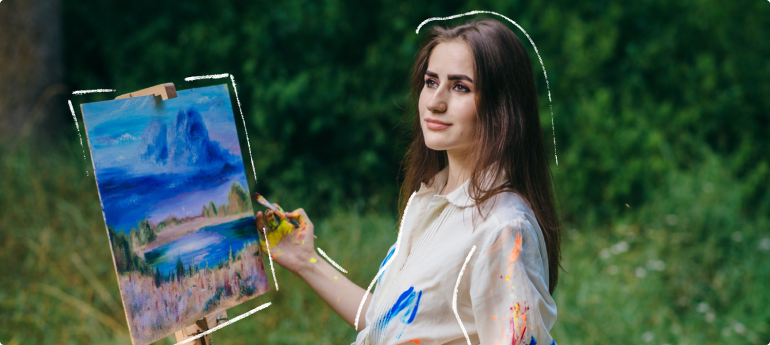
Basic oil painting set
Let’s summarize: what tools and supplies should you buy to start painting with oils?
- Canvas: choose high-quality oil canvases specifically designed for oil paints. The size depends on your preferences, but it’s often recommended to start with smaller formats for easier mastery of the technique.
- Oil Paints: stock up on a basic set of oil paints with essential colors.
- Brushes: use brushes of various shapes and sizes. For example, flat brushes are suitable for broad strokes, while round brushes are good for details.
- Thinner and Medium: a thinner will help you work with thinner layers and achieve smooth color transitions.
- Palette: buy a flat palette for mixing paints. Plastic palettes are easy to clean, while wooden ones add a touch of naturalness.
- Palette Knife: this tool allows you to create interesting textural effects and smooth the paint surface.
- Canvas Primer: applying a primer ensures good paint adhesion to the canvas surface and prevents absorption.
- Brush Holder: a convenient holder will help organize your brushes and keep them in good condition.
Ultimately, to start your creative journey with oil paints, you need only two things: courage and inspiration. Courage to challenge the fear of the blank canvas, courage to experiment with colors and forms. Inspiration will be your guide into the world of art, suggesting the stories you can tell through your paintings. So don’t be afraid to dive into this wonderful process. Your canvas is a blank page ready to become the backdrop for your ideas and fantasies. Remember, every painting is not just a work of art, but also a piece of your soul embodied on canvas. Keep these tips in mind before heading to the art store, and you’ll know exactly what to add to your cart. Good luck!
Question-answer
- Canvas: acquire a pre-stretched canvas or stretch a canvas onto a frame yourself.
- Oil Paints: start with a basic set of colors, including primary colors and shades.
- Brushes: purchase a set of brushes in various sizes for a range of textures and details.
- Turpentine or Mineral Spirits: for thinning paints and cleaning brushes.
- Palette: for mixing and preparing colors.
- Primer: if the canvas is not pre-treated, apply a layer of primer.
- Canvas Stand or Easel: for convenience when working in a vertical position.
- Old Cloth or Paper Towels: for wiping brushes and cleaning up spills.
- Painter’s Tape or Masking Tape: for creating borders or dividing areas on the canvas.
- Instructions or Tutorials: consider preparing with educational materials if you feel uncertain.
You will need the following materials:
- Canvas on a stretcher frame.
- Oil paints.
- Brushes in various sizes.
- Turpentine or mineral spirits.
- Palette.
- Primer: check if there are pre-primed canvases in the studio. If not, you may need to lightly prepare the canvas before starting.
- Easel or drawing table.
- Containers for water or turpentine.
- Old cloth or paper towels.
- Instructor’s instructions: before starting, check with your instructor for any specific instructions and recommendations for the first lesson.
- Canvas: Pre-stretched canvases are an excellent and necessary choice. They are ready to use and do not require additional preparation.
- Oil paints: It’s best to start with a basic set of primary colors.
Oil paints mix well, allowing for a wide range of shades.
- Brushes: Brushes of various sizes and shapes will help create different textures and details in your work.
- Palette: Plastic or wooden palette for mixing paints.
- Turpentine: For thinning paints and cleaning brushes. Mineral spirits can also be used.
- Water cups: For cleaning brushes after using turpentine.
- Palette knife: For mixing paints and applying them to the canvas.
- Gesso (optional): Helps improve paint adhesion to the canvas.
To create oil paintings, you will need oil paints, brushes of various sizes, canvas, a palette, a solvent for thinning paints, a palette knife for mixing, and, of course, inspiration. These tools in the hands of an artist transform oil paints into magic on the canvas.
Many specialized art stores offer a wide selection of oil painting tools. There, you will find canvases, paints, brushes, palettes, and other necessary materials.
Or consider online stores. For example, Amazon, eBay, Etsy, and many other specialized online platforms sell oil painting tools with convenient delivery.
Imagine the canvas as a magical adventure on which you have yet to start your drawing. It’s like a blank page in your own book world, where you are the author of each colorful chapter. Instead of viewing it as a challenge or a daunting emptiness, see the blank canvas as an opportunity to bring your ideas and feelings to life.
Start small, create little sketches or simply experiment with colors and shapes. Allow yourself to be creative and don’t be afraid to express your uniqueness. Remember, art is a process, not a final result, and every next step on the canvas is your personal step into the world of art. There is no need to rush.
Don’t forget to turn to the works of other artists for inspiration and support. Modern media and the internet provide a wealth of tutorials and creative ideas that can help you overcome the fear of the blank canvas and unlock your potential. Remember, every artist has faced this fear in their time, but only those who overcome it become artists.



